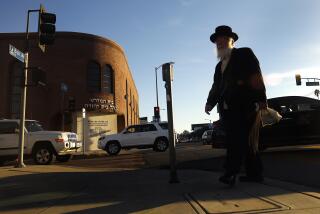An Ancient Vigil : In Orthodox Judaism, a <i> Shomer</i> Keeps Watch Over Souls of the Dead
By ordinary standards, Richard Shefter makes a lousy bodyguard: He doesn’t carry a weapon, he sometimes dozes on the job and his clients are never seen or heard from again.
But Shefter is no ordinary watchman.
He’s a shomer --one who guards the dead according to a little-known Jewish tradition that dates back at least 2,000 years.
“It’s an unusual occupation,” says Elchonon Zohn, a Queens, N.Y., rabbi who directs what is perhaps the largest paid shomer staff--25 to 30 at any one time--in the United States. “It takes a certain kind of person to do it.”
Using phones and pocket beepers, Zohn dispatches as many as 15 shomrim a night, mostly to watch and pray over the bodies of Orthodox Jews, the strictest observers of the tradition. Some Los Angeles mortuaries also offer shomer services, either by staffers or contractors.
In ancient times, shomrim guarded corpses from thieves and rodents. Today, the custom remains primarily as a sign of respect for the dead, whose souls are said to linger near their bodies until burial.
The dead shouldn’t be left alone “like a piece of luggage in a locker someplace,” says Rabbi Shloma Freed of West Hollywood’s Chevra Kadisha Mortuary.
Ideally, a relative or friend should stand watch, rabbis say, but few assume the duty. Acting in their stead are the shomrim: observant Jews, usually students, moonlighters, the semi-retired or--in the case of the Chevra Kadisha funeral home--Russian immigrants in need of work. Only a few are women (the use of females is frowned upon because of tradition).
It’s a grueling job--physically, mentally and emotionally.
Shifts typically last 12 to 24 hours because Jewish custom calls for bodies to be buried as soon after death as possible. However, holidays or late arrivals of survivors can cause delays. Jacob Kushner of Groman Mortuary in Los Angeles says he occasionally pulls a 48-hour watch and another local shomer boasts of an 87-hour session.
The shomer is supposed to remain awake the entire shift, but not many successfully resist the lure of shut-eye: “We tell families that the shomer may doze off,” Rabbi Zohn says. But even if that happens, he adds, it doesn’t violate Jewish law.
The shomer also is supposed to continuously recite Psalms and other religious texts to uplift the deceased’s soul. But that, too, proves unrealistic.
“No one is a machine that can just keep saying Psalms,” Zohn says. “It becomes almost impossible.”
He urges his shomrim to bring along crossword puzzles, books or some long-term project to wile away the hours: “Otherwise, you just get stir crazy.” But he stipulates that 20 minutes of each hour be devoted to praying: “Anything less is . . . a dereliction of our obligation to the deceased, the family and the community.”
Shefter, 36, a former rabbinical student from a heavily Orthodox Jewish section of Far Rockaway, N.Y., says he writes in a personal journal or reads from religious books between Psalm sessions: “I keep as much as I can to the spirit of what I’m doing.”
But Shefter, whose own father died nine months ago, places limits on his involvement: “I have to be somewhat detached. . . . I can’t look at it like I’m re-experiencing my father’s death (or) I couldn’t do the work. . . . I’m more of a support person for the family.”
The relatives who hire the watchers usually show considerable thanks and appreciation, despite being lost in their own grief, Shefter says.
Nevertheless, the job’s drawbacks seem to outweigh its rewards.
“People don’t treat me the same after I tell them what I do,” says a veteran watcher who is known to area morticians as “the unofficial shomer of Los Angeles.”
“They think it’s disgusting to hang around with dead bodies.” He asked that his name not be used for fear of being further ostracized.
The problem, he says, is the public’s fear of death: “I was spooked myself at first. . . . I didn’t want to do it again because of the negative perceptions I had.” But he kept at it, in part, to conquer his own demons. “I knew I had to face it--and I had the guts to do it.”
Other shomrim quit after just a few months, says Zohn, whose Chevra Kadisha Commission of the Vaad Harabonim of Queens works with 11 funeral homes in New York City and Long Island.
“Obviously, nobody wants to make a career out of it,” Rabbi Freed says. “It’s not a challenging or glorious occupation.”
But replacements have been easier to find in the current economic climate. Many, including Shefter, who has worked as a shomer for 18 months, hear about the job through friends who are shomrim.
Zohn pays $50 to $60 for a 6-hour or 12-hour shift (more if the assignment involves multiple bodies); Los Angeles shomrim usually earn $100 for 12 hours. But the work is unpredictable, says Shefter, who carries instant soup, a toothbrush and a change of clothes in his car: “It depends on factors beyond our control.”
In Israel--and some U.S. cities-- shomrim often serve on a volunteer basis. “It’s a communal responsibility with great honor to it,” says Richard Hecht, a professor of religious studies at UC Santa Barbara.
Some trace the practice of using shomrim back to Moses’ era, although formal regulations weren’t set down until the 1st or 2nd Century, Hecht says.
The same tradition also calls for a group of religious specialists to wash the body and dress it in a white hat, shirt, pants and jacket symbolizing equality and purity.
After the preparation, the body is usually kept in a refrigeration unit because Jewish tradition forbids embalming. The shomer stands guard outside and accompanies the body to the funeral.
Meal breaks are allowed--but not near the body. This would be “a mockery in front of one who is unable to eat,” says Rabbi Maurice Lamm, author of “The Jewish Way in Death and Mourning.”
In general, the life of a shomer is not for excitable, energetic types, Zohn says. “You have to be placid.”
Says Shefter: “It’s a job. I have to work. . . . (but) I’m not sure I’ll be doing this long-term.”
More to Read
Sign up for Essential California
The most important California stories and recommendations in your inbox every morning.
You may occasionally receive promotional content from the Los Angeles Times.










